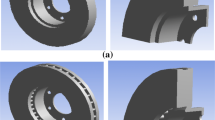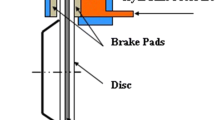Abstract
The main purpose of this study is to analyze the thermomechanical behavior of the dry contact between the brake disc and pads during the braking phase. The simulation strategy is based on computer code ANSYS11. The modeling of transient temperature in the disc is actually used to identify the factor of geometric design of the disc to install the ventilation system in vehicles. The thermal-structural analysis is then used to determine the deformation established, the von Mises stresses in the disc, and the contact pressure distribution in pads. The results are satisfactorily compared with those found in the literature.















Similar content being viewed by others
References
Milenković, P.D., Jovanović, S., Janković, A., Milovanović, M., Vitošević, N., Đorđević, M., Raičevć, M.: The influence of brake pads thermal conductivity on passenger car brake system efficiency. Therm. Sci. 14, S221–S230 (2010)
Belghazi, H.: analytical solution of unsteady heat conduction in a two-layered material in imperfect contact subjected to a moving heat source. Ph.D. Thesis, University of Limoges (2010)
Nakatsuji, T., Okubo, K., Fujii, T., Sasada, M., Noguchi, Y.: Study on Crack Initiation at Small Holes of One-piece Brake Discs. SAE technical paper 2002-01-0926. Society of Automotive Engineers (2002)
Valvano, T., Lee, K.: An Analytical Method to Predict Thermal Distortion of a Brake Rotor. SAE technical paper 2000-01-0445. Society of Automotive Engineers (2000)
Hudson, M.D., Ruhl, R.L.: Ventilated Brake Rotor Air Flow Investigation. SAE technical paper 1997-01-033. Society of Automotive Engineers (1997)
Denape, J., Laraqi, N.: Aspect thermique du frottement: mise en évidence expérimentale et éléments de modélisation. Mecan. Indust. 1, 563–579 (2000)
Hamraoui, M.: Thermal behaviour of rollers during the rolling process. Appl. Therm. Eng. 29(11–12), 2386–2390 (2009)
Hamraoui, M., Zouaoui, Z.: Modelling of heat transfer between two rollers in dry friction. Int. J. Therm. Sci. 48(6), 1243–1246 (2009)
Laraqi, N.: Velocity and relative contact size effect on the thermal constriction resistance in sliding solids. ASME J. Heat Transf. 119, 173–177 (1997)
Yapıcı, H., Genç, M.S., Özısık, G.: Transient temperature and thermal stress distributions in a hollow disk subjected to a moving uniform heat source. J. Therm. Stress 31, 476–493 (2008)
Laraqi, N., Alilat, N., Garcia-de-Maria, J.M., Baïri, A.: Temperature and division of heat in a pin-on-disc frictional device—exact analytical solution. Wear 266(7–8), 765–770 (2009)
Bauzin, J.G., Laraqi, N.: Simultaneous estimation of frictional heat flux and two thermal contact parameters for sliding solids. Numer. Heat Transf. 45(4), 313–328 (2004)
Baïri, A., Garcia-de-Maria, J.M., Laraqi, N.: Effect of thickness and thermal properties of film on the thermal behavior of moving rough interfaces. Eur. Phys. J. Appl. Phys. 26(1), 29–34 (2004)
Mijuca, D.M., Iberna, A.M., Medjo, B.I.: A new multifield finite element method in steady state heat analysis. Therm. Sci. 9(1), 111–130 (2005)
Zhang, L., Yang, Q., Weichert, D., Tan, N.: Simulation and analysis of thermal fatigue based on imperfection model of brake discs. PAMM Proc. Appl. Math. Mech. 9, 533–534 (2009)
Fiche, U.I.C.: 541-3: FREIN – Frein à disques et garnitures de frein à disques, 4th ed. (1993)
Saumweber, E.: Temperaturberechnung in Bremsscheiben fürein beliebiges. Fahrprogramm, Leichtbau der Verkehrsfahrzeuge, Heft 3, Augsburg (1969)
Cruceanu, C.: Frâne pentru vehicule feroviare (Brakes for railway vehicles), Bucureşti, 388 pages, ISBN 978-973-755-200-6 (2007)
Reimpel, J.: Technologie de freinage. Vogel Verlag, Würzburg (1998)
Gotowicki, P.F., Nigrelli, V., Mariotti, G.V.: Numerical and experimental analysis of a pegs-wing ventilated disk brake rotor, with pads and cylinders. Paper EAEC05YUAS04-P5, 10th EAEC European Automotive Congress (June 2005)
Yu, H., Li, S., Liu, Y., Chen, C.: Study on temperature distribution due to freezing and thawing at the Fengman concrete gravity dam. Therm. Sci. 15(suppl. 1), s27–s32 (2011)
Sergerlind, L.J.: Applied Finite Element Analysis. John Wiley and Sons, New York (1984)
Hinton, E., Owen, D.R.J.: An Introduction to Finite Element Computations. Pineridge Press Limited, UK (1981)
Versteeg, H.K., Malalasekera, W.: An Introduction to Computational Fluid Mechanics. The Finite Volume Method. Longman Scientific & Technical Publishers, Harlow (2007)
ANSYS v.11 User’s Manual Guide. ANSYS, Inc., Houston, USA (1996)
Nouby, M., Srinivasan, K.: Parametric studies of disc brake squeal using Finite element approach. India J. Mek. 29, 52–66 (2009)
Author information
Authors and Affiliations
Corresponding author
Rights and permissions
About this article
Cite this article
Belhocine, A., Bouchetara, M. Thermomechanical Coupling Analysis of a Disc Brake Rotor. J Fail. Anal. and Preven. 12, 697–706 (2012). https://doi.org/10.1007/s11668-012-9616-7
Received:
Revised:
Published:
Issue Date:
DOI: https://doi.org/10.1007/s11668-012-9616-7




